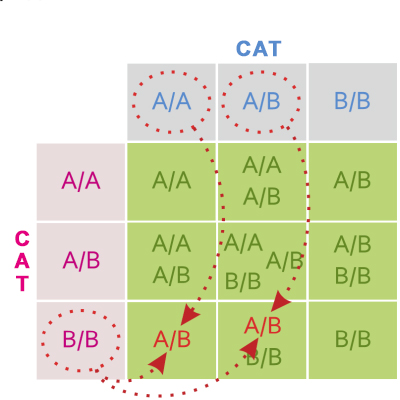![]() On the territory of the Russian Federation, all payments are made in rubles.
On the territory of the Russian Federation, all payments are made in rubles.
For actual prices in EURO please contact our representatives.
| Code | Title | Term of completion, working days | |
|---|---|---|---|
| CSG001 | Cat Blood Groups | 5 |

Blood group - a sign determined by the individual antigenic characteristics of erythrocytes - red blood cells.
Unlike humans, dogs, horses and most other mammalian species, only one blood group system has been described for the domestic cat, which includes two main types - blood group A and blood group B , as well as a very rare blood group AB (blood groups are usually denoted in Latin letters).
Most cats are of blood type A , but there are a number of breeds in which type B is also common. For example, the frequency of occurrence of blood group B in British cats, Cornish and Devon Rex reaches from 25 to 50%, while it is extremely rare for Siamese and related breeds.
Knowing your pet's blood type is usually important in two ways:
- if necessary, transfusion (blood transfusion);
- when planning a mating.
Like the human AB0 blood group system, cats of one blood group have antibodies to the other in their blood. However, antibodies from different blood groups exhibit different activity. Thus, the antibodies of cats with blood group B actively bind foreign red blood cells contained in the cat's blood with group A and destroy them, while antibodies circulating in the cat's blood are blood groups A , show much less activity. It is interesting to note that cats of blood type AB are universal recipients, i.e. do not show a reaction of "rejection" of blood of other types, which is associated with the absence of antibodies to other groups.
Kittens born from a couple where the cat is blood type B , and the cat is A , may face a sad fate - "Sudden Kitten Death Syndrome". Kittens develop normally in the womb, but die soon after birth.
At first, the kitten's immune system is very weak, and the mother, along with the milk, transfers her antibodies to him, which are absorbed through the wall of the baby's intestines and enter his bloodstream. In case of incompatibility between the blood group of the cat and the kitten (the cat has blood group B , the kitten has A ), the mother's antibodies attack the kitten's erythrocytes, causing them to agglutinate, i.e. destruction. As a result, the baby develops anemia and metabolic disorders, which can lead to death.
In some cases, despite the incompatibility, kittens survive. This is due to the individual characteristics of the body, such as, for example, low absorption by the intestinal walls in the first days after birth.
Currently, a cat's blood type can be determined with a DNA test.
The following genetic nomenclature is used to denote blood groups:
|
Blood type |
Allele |
Genotype |
|
A |
A |
A / A, A / a ab , A / b |
|
АB |
a ab |
a ab / a ab , a ab / b |
|
B |
b |
b / b |
Allele of blood group A is dominant in relation to alleles a ab and b, allele a ab dominates the allele b (A & gt; a ab & gt; b). The genetic test identifies cats with blood type B with two copies of the allele b and cats - carriers with only one copy of the allele b . In the second case, the animal may have blood group A or AB . Because the genetic test does not distinguish between A alleles and aab , it is customary to use the convention “ not B ” allele ( Non - B or just " N ")
DNA test results:
|
Genotype |
Meaning |
|
N / N |
- blood type A or rare type AB |
|
N / b |
- blood type A or AB, carrier of blood type B |
|
b / b |
- blood type B |
By choosing the right pair, you can avoid the problem of hemolysis in the offspring. The table shows possible variants of kittens' genotypes depending on the genotypes of the parents.
|
CAT |
||||
|
N / N |
N / b |
b / b |
||
|
CAT |
N / N |
N / N |
N / N, N / b |
N / b |
|
N / b |
N / N, N / b |
N / N, N / b, b / b |
N / b, b / b |
|
|
b / b |
N / b |
N / b , b / b |
b / b |
|
Note: the genotypes of the cat are highlighted in blue, the genotypes of the cat are in pink, the genotypes of the kittens are in green. The genotypes of the kittens at risk are highlighted in red.


